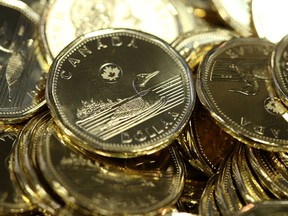Cost of items susceptible to a weaker loonie registered increases, economist says
Article content
The “thumbprints” of a weaker Canadian dollar made their mark in January’s consumer price index (CPI) report, well-known Bay Street economist David Rosenberg said.
Article content
Article content
“The weak Canadian dollar had its thumbprints all over this report,” the founder and chief economist of Rosenberg Research & Associates Inc. said in a note on Tuesday following the release of the latest CPI data.
Advertisement 2
Article content
Inflation grew at a rate of 1.9 per cent year over year and up from 1.8 per cent in December, according to Statistics Canada.
Most of the increase was attributed to a rise in gasoline and other energy prices, but Rosenberg said the cost of items susceptible to a weaker Canadian dollar also registered increases.
“You’re starting to see the first signs of the weakness in the Canadian dollar starting to percolate through the price data,” he said in a followup interview.
For example, new vehicle prices rose 2.3 per cent year over year in January, while clothing and furniture prices also rose on a seasonally adjusted basis.
“What makes (these items) different is they have quite a bit of sensitivity to shifts in the Canadian dollar, more than is the case with health and personal care, recreation and education, and home entertainment,” he said. “Those are, principally, the areas that caught my eye, telling me that the impact of the softer loonie is beginning to percolate through.”
The Canadian dollar has been riding a losing streak against its United States counterpart since late September, when polls in the U.S. started to indicate that Donald Trump was gaining momentum in the presidential race against Kamala Harris.
Article content
Advertisement 3
Article content
At the time, the loonie was trading at 74.5 cents U.S. It is currently trading at 70.5 per cent U.S.
We will need a weaker dollar to prevent disinflation from morphing into deflation
David Rosenberg
The currency hit a low in the so-called Trump trade cycle of 68.8 cents U.S. on Feb. 1, just before the president’s 25 per cent across-the-board tariffs were expected to be levied. The tariffs have since been delayed until March.
Trump’s arrival as president has been bad for the Canadian dollar because his stated love for tariffs would hit the Canadian economy if he implements them, causing the Bank of Canada to defend growth by putting lower interest rates in place.
Tariffs could also trigger a rise in U.S. inflation and U.S. Federal Reserve interest rates. But higher rates south of the border make the greenback more attractive to investors, causing other currencies paired with the U.S. dollar to lose value.
With global uncertainty at heightened levels — even if it’s caused by Trump — investors will feel compelled to rush to the U.S. dollar for safety, putting further downside risks on the loonie.
But Rosenberg thinks the loonie and the lower interest rates will ultimately guard against disinflation.
Advertisement 4
Article content
“Lower interest rates and a lower Canadian dollar in tandem will … act as an antidote against these other domestic disinflation pressures, especially at a time when many measures of inflation and underlying inflation are already at or near the Bank of Canada comfort zone,” he said.
Rosenberg is among those who expect the Bank of Canada to continue cutting to at least the bottom of its two per target range and possibly lower, despite what happens with tariffs.
Recommended from Editorial
-

Loonie nearing 71 cents as US ‘tariff fatigue’ sets in
-

Loonie trades above 70 cents US as tariff threat recedes
He said policymakers have recently indicated they consider the Canadian economy will be in “excess supply” until the end of next year, which will keep pushing prices down.
“We will need a weaker dollar to prevent disinflation from morphing into deflation (where the rate of inflation falls below zero),” he said.
• Email: gmvsuhanic@postmedia.com
Bookmark our website and support our journalism: Don’t miss the business news you need to know — add financialpost.com to your bookmarks and sign up for our newsletters here.
Article content
Canadian dollar leaves ‘thumbprints’ on inflation report
2025-02-18 21:34:58







